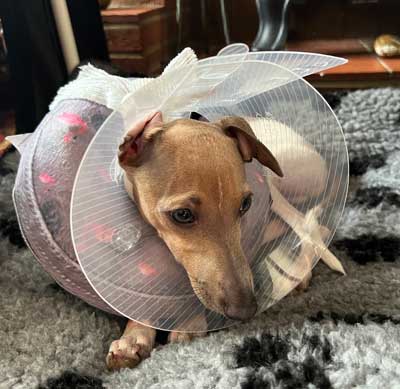With the excitement (and often chaos!) of bringing home your new puppy, it’s easy to forget about the behind-the-scenes necessities, dog insurance cover being one of them. It might seem as though there is plenty of time to sort this out but, the fact is, puppies can and do injure themselves, get lost, or become unwell and it can happen at any moment. Choosing your dog insurance cover can be confusing and takes time to conclude, so it’s wise to investigate the options before bringing your puppy home.
This article is not intended to recommend insurance companies or cover, but to highlight how the components of the dog insurance cover might apply to ‘real life’.
Don’t rely solely on any free insurance cover that your dog comes with

It’s quite common nowadays to be offered 4 or 5 weeks free insurance cover with your new puppy or adult dog. This is either through the Breeder’s insurance, or through the dog’s Microchip company. This is a fantastic safety-net in case you have not yet started full cover and are unfortunate enough to require expensive veterinary care. Additionally, as awful as it is to imagine, it can include a percentage reimbursement of purchase price should your puppy die or be put to sleep. In some cases, the free insurance provides a fund for advertising and reward should your puppy go missing or be stolen.
However, these free insurance policies do have limitations. Veterinary cover is limited, usually to around just £4000. The cover usually does not include the extensive treatment options the full cover provides. For example, a broken leg requiring surgery is likely to cost a minimum of £3,500, leaving you very little cover for subsequent follow up care and x-rays.
Another very important consideration to take is that any accidents or ailments you make a claim for will almost certainly be excluded from your future full cover, unless you continue with the insurer providing the free insurance cover and they offer Lifetime Cover.
While the safety-net of this free insurance cover is fantastic to have, it is exactly that; simply something to fall back on if you should need to claim before you have arranged your ongoing cover.
What is ‘Lifetime Cover’?
Lifetime cover is an important option when choosing your dog insurance cover. Without Lifetime Cover, the insurance cover starts from scratch like a brand-new policy every year, and anything you have claimed for during the previous 12 months will almost certainly be excluded from cover from the following renewal. Lifetime Cover means that full cover remains in place at renewal, no matter what claim you make at any time. For example, if your dog breaks a leg and has surgery to insert pins and a plate, with standard cover that leg break will no longer be covered when the policy renews – even if the renewal falls mid-treatment! Should your puppy require follow up x-rays, or even surgery to remove the plate in future, the veterinary fees for this will not be covered and you will need to fund the bills for these yourself. Lifetime Cover protects you from this. You can continue to claim for ongoing treatment for life, providing your insurance cover remains in place. The premiums for Lifetime Cover are invariably more expensive but will offer tremendous peace of mind when you need to make a claim.
How much veterinary care cover do I need?
The answer to this question is, “however much you can afford”. When choosing your dog insurance cover, you will usually be faced with varying levels of insurance cover. I know from speaking with friends and reading posts on social media, £6000 per condition per year can sound like a lot. The reality is veterinary fees will consume that budget in no time. Your veterinary care cover will usually include rehabilitation, like hydrotherapy, myotherapy, shockwave therapy etc., which need to be factored into the budget for a lot of accidents and ailments.

Important tip: Always choose lifetime cover. Also, always choose the highest level of veterinary cover you can afford going forward. Bear in mind, if you choose to increase your level of veterinary cover later, many insurance companies will cancel your existing policy and start a new one afresh. This means anything you have claimed for to date will be excluded from your cover going forward. In real terms, should your dog be unlucky enough to break a leg or damage a tendon, and require surgery to insert a metal plate, if you seek to increase your veterinary cover at a later date this injury will no longer be covered. This might not seem important because it is a past problem, however, if your dog injures that leg again or should suffer plate rejection and require further surgery, you will not be covered.
“It happened to me”
“I took out £6,500 a year in veterinary cover thinking that was a big fund. 4 years later I realise that no longer offers adequate cover. When I called to increase my cover, my insurance company advised they would start my cover anew and the puppyhood pancreatitis we claimed for is no longer covered, should it reoccur at any point from now on. My advice is to think ahead when choosing veterinary cover. I never expected to have to start afresh to upgrade my veterinary cover. Dog insurance is not like mobile phone contracts in that respect.“
“I brought my Italian Greyhound puppy home on the Sunday and a few days later he broke his leg while enthusiastically ‘ragging’ a toy on the hard floor of the kitchen. We only had £4000 veterinary cover on the free Breeder’s insurance. Thankfully, this just about covered the surgery and follow up X-rays, everything else we covered out of our own pocket. We were then bound over to lifetime insurance from that same company, in order to keep that leg break covered in the event of plate rejection or other potential future problems with that leg, thus removing our freedom to choose our insurance company. My advice is to take out full cover to start as you bring your new puppy or adult dog home. I researched insurance the day before we collected him. I didn’t want to commit at that point. I’ve since realised we have a 14 day cooling off period by law – please use it! Don’t leave insurance to luck! I never in a million years thought this would happen to us, yet it did.“
“I decided to change insurance cover when my Italian Greyhound was 2 years old. I took out my new cover and cancelled my old cover. Then, against all odds, my beautiful girl broke her leg. My new insurance cover wouldn’t pay out because I was within their 14 day buffer period. My old insurance wouldn’t pay out because I had cancelled it already. Rather than preferred surgery, I ended up crowd-funding a devastating, yet cheaper amputation. Had I only paid attention and waited to cancel my existing policy until after the buffer period on the new policy, I’d have been covered. My advice is to check any limitations period on a new policy – it’s better to be double-covered than not covered at all when changing insurance policies.“
Words of advice on choosing the right dog insurance cover

- ALWAYS read the small print and make sure you understand the finer details. If there is anything you are unsure about, call the insurance company and ask them. Never leave anything to luck.
- Start insurance cover in advance and consider starting it from when you bring your puppy home. By law you have a 14 day ‘cooling off period’ with all insurance companies, so if you do change your mind, you are free to cancel the policy within that time. It is far safer to have full cover in place in case you are unfortunate enough for your puppy to be dropped, fall, or become ill in the first hours/days of you owning them. Puppies are lively and often do mad things, and accidents happen.
- Be mindful of choosing cover for life, i.e. you might not be able to easily switch to another company in future. The majority of the popular insurance companies offer Lifetime Cover and once you make any claim, you risk losing cover for that injury or ailment if you switch providers. So, you need to be able to commit to that insurance company for the lifetime of your dog, if needs be.
- You get what you pay for. If the insurance premiums are much cheaper than average, the chances are the cover has limitations to match. Many of us feel that high insurance premiums are “a bit of a waste of time”, but if you find yourself needing to make a big claim, it will be such a tremendous relief to know you are adequately covered. Having to crowdfund your sick/injured dog’s treatment is an additional stress, and having to make heart-breaking decisions on amputations, ceasing/shunning chemotherapy treatment, euthanasia etc will sharpen focus when it is too late.
- Read reviews on insurance companies. No insurance company is going to have a clean 5-star reputation, there are always going to be individuals who have exceptional circumstances, but the majority will give you an idea of what to expect. Some insurance companies have recently hiked premiums by as much as 60% or more, and customers who’ve claimed on Lifetime Cover are held to ransom paying these premiums or lose cover for previous and existing conditions. You will identify these quite easily from recent reviews. Some insurance companies have pledged to cap their premium rises, so do your homework on this.
- Accidents and illnesses happen at ANY time. A common plan with pet owners is to put premium payments away every month instead of paying them to an insurance company, on the basis that the insurance company will try to wriggle out of paying. Just keep in mind that you would have to save a premium of £60 a month for 6-9 years to cover the average cost of chemotherapy or a broken leg. Given that most leg breaks occur within the first 12-18 months of a dog’s life (regardless of breed), you need to know you already have that money to hand when you take on your dog, not rely on saving it over a considerable number of years. In my experience, this goes back to point 4. You get what you pay for. If an insurance cover is particularly cheap, or “good value”, do try to find out why. There are insurance companies out there that pay out on 97% of claims, but they will not always be the cheapest (but not necessarily the dearest) cover available. Do thoroughly research your options.
Hopefully, you will not need to make big, if any, claims on your dog insurance but if you do, you will be glad to have taken these steps and considerations early on!
The content provided in this article is for advisory purposes only. It is the responsibility of the individual to ensure that the information they are working to is correct and appropriate for their specific circumstances.
© Kelly Wallace Horne, The Italian Greyhound Club, Italian Greyhound Active Health Project 2023. Unauthorised use and/or duplication of this material without express and written permission from this site’s author and/or owner is strictly prohibited. Excerpts and links may be used, provided that full and clear credit is given to Kelly Wallace Horne, The Italian Greyhound Club, and www.italiangreyhoundactivehealth.org.uk with appropriate and specific direction to the original content.









